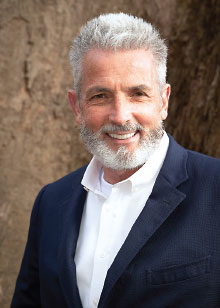Mark McGovern, Ph.D., a professor of psychiatry and behavioral sciences at Stanford University, knows firsthand how difficult it can be to turn a great idea into a great reality.
In 2009, McGovern, then an associate professor of psychiatry at Dartmouth Medical School, developed a cognitive-behavioral therapy (CBT) that addressed posttraumatic stress disorder (PTSD) in people who also had a substance use disorder (SUD). The integrated psychotherapy was designed to be used by therapists who specialized in addiction counseling (including nurse practitioners and social workers) in community mental health centers.
After a
pilot study demonstrated that the PTSD-SUD psychotherapy could be effectively delivered in community mental health centers and was associated with patient improvements, McGovern was invited by numerous county and state organizations to provide training for their community therapists.
“As much as the centers seemed hungry for [the PTSD-SUD] intervention, it never got off the ground,” McGovern told Psychiatric News. “My research went from bench to bookshelf.”
Several of McGovern’s colleagues who had developed evidence-based behavioral interventions reported the same struggle: Mental health centers faced great challenges implementing what clinical trials had suggested was an effective treatment. Some of these centers tried and failed to implement the interventions; others chose not to even try. Why?
In 2010, a study of child mental health services conducted across 14 rural counties in Eastern Tennessee suggested that the success or failure of behavioral health programs may stem from the structure of the organization.
The study involved over 600 youth with behavioral issues who were randomly assigned to receive an intensive, family-based therapy program or their usual care. In six of the 14 counties, the community health center staff received training to improve teamwork and goal setting while the other eight counties did not receive this training. The youth who received the intensive therapy from a center whose staff received training had better behavioral outcomes than youth who received the intensive therapy from staff who did not receive training or youth who received usual care from trained staff.
Overcoming barriers
McGovern said that the Tennessee study underscored the need for rigorous implementation science research in mental health. (Implementation science is a burgeoning field that explores how to expedite clinical innovations that worked in controlled trials into routine care.) In 2017, McGovern moved to California to establish and direct the
Center for Behavioral Health Services and Implementation Research at Stanford.
Though implementation science is a little over a decade old in psychiatry, the field has advanced quickly, McGovern said. “One positive from all the failures [of the implementation of behavioral health programs] was that we had a pretty good initial sense of the barriers we needed to overcome,” he said. “Researchers could move quickly from developing models to overcome these barriers to developing standard measures so we can compare outcomes from different projects, such as urban versus rural health services.”
Staying close to his clinical roots (having started his career as an addiction psychiatrist in Chicago), McGovern has focused extensively on improving patient access to opioid use disorder medications such as buprenorphine and methadone. One of his center’s largest projects involves testing a tiered approach to increase opioid medication therapy across 64 primary care or addiction clinics across Washington state. The project is meant to encourage the clinics to meet certain benchmarks for quality OUD care (for example, ensuring qualified patients receive medications quickly after diagnosis) through a series of progressively intensive organizational interventions.
The first step is to increase physician auditing and provide performance feedback every three months; if benchmarks are still not met, the next step is to enroll the center in a two-day workshop on ways to improve prescribing practices. Finally, external consultants can be brought in to help identify barriers to prescribing and ways to overcome those barriers. The concept is that every center gets only the “push” that it needs and resources are not wasted, McGovern said.
“We’ve learned quickly that there is no ‘one-size-fits all’ approach to improve health care delivery,” McGovern said. “Every clinic has its own contextual factors that can make or break the adoption of new practices.” In one place, the problem may be limited resources, while at another center the issue may be stigma. Organizational-level interventions that offer flexibility or stepped options can work the best, McGovern said.
The next big priority of the Stanford Implementation Research Center is to make sure the fruits of implementation research reach all communities and patients. “A central mission statement of our center is that where we have inequity, we have implementation failure.”
McGovern and his team are working on multiple fronts to tackle inequity in substance use care, especially stimulant use disorder. And unlike for opioid use disorder, no medications have received Food and Drug Administration approval for stimulant use disorder, which makes medication therapy more challenging. One of his projects is testing whether contingency management (encouraging attendance at therapy by offering incentives like cash) can improve treatment adherence for substance use disorders in publicly funded addiction clinics, while a second is exploring the potential benefits of mobile apps and other digital tools in bridging the socioeconomic disparities in access to substance use treatment.
Finally, his team is also working with several counties across the United States to track the history of people who died from drug overdoses. “We want to identify the final clinical ‘touch point’ for overdose victims; was it at a hospital, another health center, or even a criminal justice facility? Seeing the places where these people made contact can help us prioritize our overdose prevention strategies.”
McGovern told Psychiatric News that overseeing projects that involve entire health centers rather than individuals can be challenging, particularly in recruiting and retaining organizations. But the payoff can be immense: “If our primary outcome is successful, then we have not bettered 50 lives, but potentially 50,000, and that is a great feeling.” ■


